In the modern gaming world, anti-aliasing is one of the most important techniques to achieve a smooth and clean image. Anti-aliasing is a technology that helps to reduce or eliminate the stair-stepping and jagged edges of objects in a digital image.
They let you crank up the graphics quality to a much higher level while preserving much better image quality. They also help avoid aliasing artifacts and unsightly graphical glitches when rendering a scene.
There are many types of anti-aliasing, each of which has advantages and disadvantages. This article will compare FXAA, SMAA, TAA, and MSAA.
What is FXAA?
FXAA is a fast, lightweight, and easy-to-use post-processing technique that helps to reduce aliasing artifacts. It was designed to be used in addition to other anti-aliasing techniques, such as MSAA or SMAA.
FXAA is implemented as a shader program that runs on the GPU. It blurs the image slightly and then applies a strong blurring filter to the edge pixels. This helps smooth the edges and eliminate the stair-stepping and jagged lines.
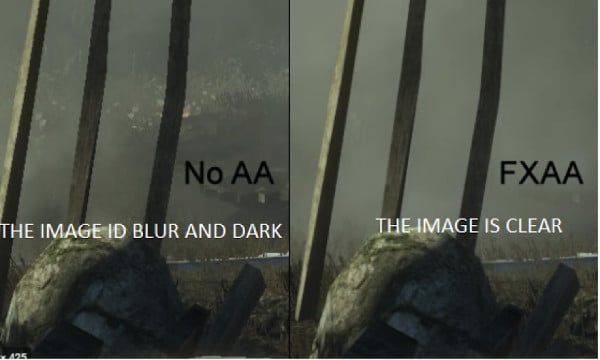
FXAA is a good choice for gamers looking for a quick and easy way to improve image quality. It is also very effective at reducing aliasing artifacts. However, FXAA can sometimes cause blurring and loss of detail in the image.
What is SMAA?
SMAA is a SMART Anti-Aliasing technique. It is a post-processing filter that helps to reduce aliasing artifacts and improve image quality. It is available on many platforms, including Windows, macOS, Linux, and Android.
SMAA combines morphological anti-aliasing (MAA), hardware-accelerated multi-sampling, and temporal filtering to achieve the best results.
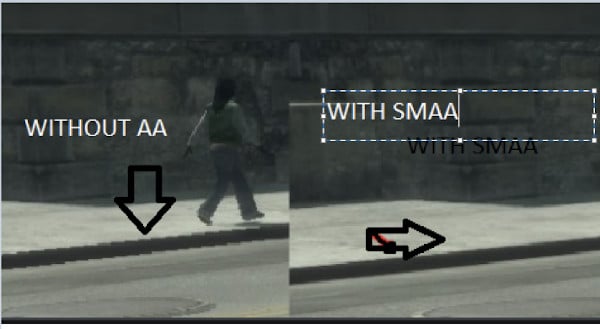
What is TAA?
TAA stands for temporal anti-aliasing and is a technique that improves image quality by eliminating aliasing artifacts and smoothing out edges. An algorithm uses temporal sampling to combine frames and remove flickering and shimmering.
This technique effectively reduces or eliminates all types of aliasing but can also cause some image blurring.
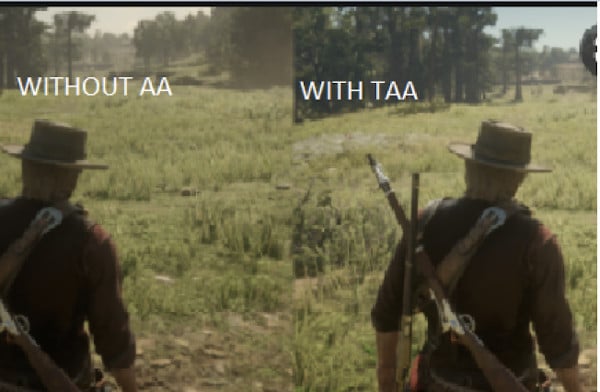
What is MSAA?
MSAA is a type of Anti-Aliasing that is used in 3D rendering. It is a hardware-based technique that samples the image at multiple points and then combines the results to remove the aliasing artifacts.
MSAA is available on most modern graphics cards and can be enabled through the settings of your graphics card control panel. MSAA is a very effective technique but can also tax your system.
It can cause a significant drop in performance, so you may need to lower the quality of your graphics settings to maintain a playable frame rate.
Difference Between FXAA, SMAA, TAA, and MSAA
Various anti-aliasing techniques are used in video games: FXAA, SMAA, TAA, and MSAA. But what’s the difference between them?
FXAA is a fast, lightweight, anti-aliasing technique that can be used with other effects, such as HDR and depth of field. It smooths out edges by applying a small amount of blur and effectively removes jagged lines and other aliasing artifacts. However, it can also cause some blurring of textures and details.
SMAA is a more powerful anti-aliasing technique that uses a different approach to smoothing edges. It’s more accurate than FXAA and can reduce the blurring caused by textures and details. However, it’s also more resource-intensive and can slow down your game.
TAA is a technique that combines FXAA with SMAA to provide the best of both worlds. It offers good performance and smooth edges without causing too much blurring.
MSAA is a more powerful anti-aliasing technique that uses a different approach to smoothing edges. It’s more accurate than FXAA and can reduce the blurring caused by textures and details. However, it’s also more resource-intensive and can slow down your game.
Which anti-aliasing technique is right for you depends on your preferences and hardware. FXAA is a good choice for those who want a fast, lightweight solution, while SMAA offers better results with a small performance hit. TAA offers the best of both worlds, while MSAA is a more powerful option for those who need the best possible results.
Other differences include:
- FXAA is a post-processing effect, while the others are hardware based. This means that FXAA is applied after the image has been rendered, while the others are applied before.
- MSAA is available in 2x, 4x, 8x, and 16x variants. It smooths out edges more effectively than FXAA but is also more resource-intensive.
- TAA is only available in a single variant. It combines FXAA and SMAA to provide the best results.
- TAA is a combination of FXAA and SMAA.
- SMAA is more accurate than FXAA. The accuracy is determined by the Sub-pixel Morphological Anti-Aliasing (SMAA) technology.
- FXAA is faster and more lightweight than SMAA.
- MSAA requires a more powerful graphics card than FXAA, SMAA, or TAA.
- MSAA is more resource-intensive than FXAA. This means it can slow down your game.-TAA is the most resource-intensive of the four options. This makes TAA less suitable for low-end systems.
Is FXAA or TAA Better?
When comparing FXAA and TAA, you are looking at two very different types of anti-aliasing. FXAA is a post-process filter that is applied to the entire image, while TAA is a technique that is applied to certain edges in the image.
FXAA is a fast option that can be used on any graphics card. TAA is a little more demanding but can provide impressive results.
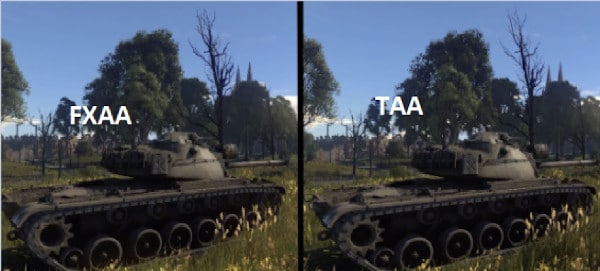
Ultimately, which one you choose will come down to your personal preferences. FXAA is more subtle, while TAA can be a little more jarring. However, TAA can also provide a much more realistic image.
Determining which is better depends on what you are looking for. If you want the best image quality, TAA is the better option. However, if you want the best performance, then FXAA is the better option. Overall, FAA is a great option for both quality and performance.
Is TAA or MSAA Better?
If you want the best image quality for your games, you may wonder which anti-aliasing method is the best between TAA and MSAA. Both methods offer great image quality, but there are some key differences between them.
As TAA samples all of the pixels in a scene, it can smooth out edges far more effectively than MSAA. However, MSAA is better at dealing with aliasing textures, as it can smooth out the edges of individual textures.
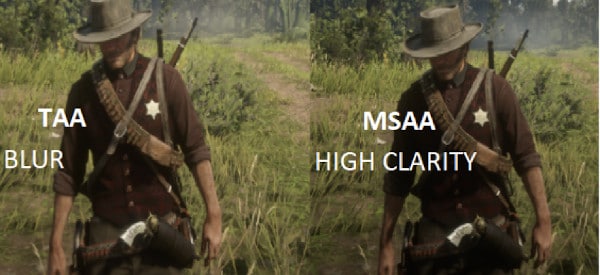
However, if you consider choosing between the two, TAA is the better option as it offers a much higher quality image than MSAA.
What Methods Are Used in Anti-Aliasing?
Anti-aliasing is a technique used in graphics processing to smooth out the appearance of jagged edges in a digital image. There are several methods for achieving anti-aliasing, each with its pros and cons.
The following are the two pain methods used in anti-aliasing:
- Shader-based AA methods: FXAA, SMAA, and TAA are all shader-based AA methods. They work by applying an edge detection filter to the image and then using the filter results to apply a smoothing effect. These three methods effectively smooth out jagged edges but can also cause some image blurring.
They are also very fast and can be used on most graphics hardware.
. - Sampling-based AA methods: MSAA is the only sampling-based AA method. It takes multiple samples of each pixel and then combines the results to produce a smooth image.
This method is very effective at smoothing out jagged edges but can also cause significant image blurring.
It is also relatively slow and can only be used on graphics hardware that supports multi-sampling.
Which Method is the Best?
There is no one “best” method for anti-aliasing. Each method has strengths and weaknesses, and what works for one person may not work for another.
The best method to use depends on your specific needs and preferences. If you want the best image quality, then sampling-based AA methods like MSAA are the best choice.
If you want a fast, lightweight solution that still provides good image quality, shader-based AA methods like FXAA, SMAA, and TAA are the best.
Regardless of your chosen method, anti-aliasing is an important step in improving the appearance of your digital images. Using one of the methods described above, you can smooth out the jagged edges and make your images look their best.
How Do I Turn Off Nvidia FXAA?
To turn off Nvidia FXAA, follow these steps:
- Open the Nvidia Control Panel.
- Go to Manage 3D Settings.
- Under the Antialiasing Mode drop-down menu, select Off.
- Click Apply and then OK.
- FXAA will now be disabled.
How Do I Turn Off AMD FXAA?
To turn off AMD FXAA, follow these steps:
- Open the Catalyst Control Center.
- Go to Graphics Options.
- Under the Anti-Aliasing Method drop-down menu, select Off.
- Click Apply and then OK.
- FXAA will now be disabled.
Frequently Asked Questions
Is FXAA the Best Anti-Aliasing?
FXAA is a popular anti-aliasing technique used in games for many years. It is fast and lightweight, making it ideal for those who want to reduce aliasing without sacrificing performance or image quality.
However, while it makes a noticeable difference in reducing jaggies, it doesn’t offer the same quality level as other techniques like SMAA.
Does TAA Reduce FPS?
TAA, or temporal anti-aliasing, is a powerful technique that can deliver smooth visuals with minimal interference. The drawback to this method is that it often results in significant FPS drops, an unwelcome surprise for players who want the best graphics without sacrificing performance.
Should I Turn Off FXAA?
When playing a graphic-intensive game, it is important to consider the compromise between performance and image quality. FXAA is an anti-aliasing technique that can help minimize pixelation and jagged edges; however, this comes at the cost of reduced frames per second.
If you are experiencing lower than desired FPS, disabling FXAA might be a viable option for improving your game’s performance without sacrificing visual fidelity.
Which Anti-Aliasing Technique Should I Use?
When it comes to anti-aliasing techniques, deciding which to use can be tough – especially if you don’t know what each one is capable of. If you’re rocking a top-notch, high-end machine, SSAA is generally the way for the most impressive graphics.
But those with mid-range PCs should probably opt for FXAA to get the best FPS out of their machine. Of course, it all boils down to personal preference, and you might find that tinkering with your settings will give you an optimal balance between good graphics and FPS.
Is FXAA Good For FPS?
Regarding FPS and anti-aliasing, FXAA is an attractive choice as it offers a good balance of performance and image quality. It has almost no impact on performance compared to the much more demanding SSAA or MSAA, which can reduce your framerates significantly.
On the other hand, the SMAA method takes the middle ground between those two extremes, providing better performance than SSAA or MSAA while avoiding the blurring usually associated with FXAA by only blurring edges.
While most gamers and developers look down upon FXAA due to its blurring effects, it’s still a useful technique in many cases.
What is Anisotropic FXAA?
Anisotropic FXAA is a form of texture filtering that improves an image’s appearance quality. Using this type of filtering, textures are sharpened, resulting in a better-looking presentation.
Meanwhile, antialiasing techniques like FXAA and TXAA eliminate jagged edges from rendered images and smooth them out for a more natural-looking result.
However, it is important to note that not every technique yields identical results in a degree of success – some may see more drastic improvement than others, depending on their situation. Nevertheless, Anisotropic FXAA provides additional optimization levels and is worth taking advantage of.
Is TAA or SMAA Better?
Deciding on which anti-aliasing technique to use can be a difficult decision. TAA and SMAA offer great advantages, but when it comes down to which results in better visuals, TAA is the clear winner.
With its more advanced options, TAA can remove image jaggies without too much performance loss while producing stunningly life-like images. On the other hand, SMAA focuses more on speed than image quality and may result in some artifacts that could easily ruin the gaming experience.
Ultimately, both techniques have their merits, and you should try them out to see which one works best for your needs.
What FPS Should I Target?
With so many options for frame rates available, it can be hard to decide what FPS you should target. When it comes to gaming, balancing frame rate and graphics quality is crucial.
If a higher frame rate is preferred to enhance your gameplay experience, 60 FPS is recommended, as it provides an incredibly smooth response. However, a lower frame rate tends to do the trick if you want more processed and detailed graphics on the screen.
Ultimately with gaming, the decision is yours and varies depending on what style of games you prefer. If you’re striving to balance visuals and gameplay, 45 FPS is an ideal target. This way, you don’t have to sacrifice much in either area.
Do I Need High End Graphics on My Computer?
If you are someone who wants the full gaming experience and enjoys playing hardcore titles, invest in a higher-end graphics card for your computer.
A budget graphics card may have you enjoying some light gaming. Still, if it’s important for you to be able to do more advanced tasks like serious video editing or 3D animation, a high-end graphics card is ideal.
That way, you will get the best performance when playing graphically heavy games and rendering your projects.
Deciding on getting a high-end graphics card should ultimately depend on how much time you intend to spend playing or editing visuals and what quality you want to achieve.
Can I Use the Four Types of Antialiasing Together?
Yes, you can use all four types of anti-aliasing together, but it will result in a significant performance hit. If you’re looking for the best image quality, we recommend using FXAA, SMAA, and MSAA in that order.
TAA should only be used if you’re experiencing aliasing issues that cannot be fixed with the other three types of anti-aliasing.
Conclusion
FXAA, SMAA, TAA, and MSAA are all effective anti-aliasing techniques. However, each technique has its advantages and disadvantages. You should try out each technique to see which one you prefer.
All of them will help reduce aliasing in your image, but FXAA is the fastest and most lightweight. TAA is the most powerful but can also significantly reduce your FPS. SMAA is the fastest and most lightweight but may be less effective than TAA or FXAA. MSAA is the most expensive, but it produces the best results.






